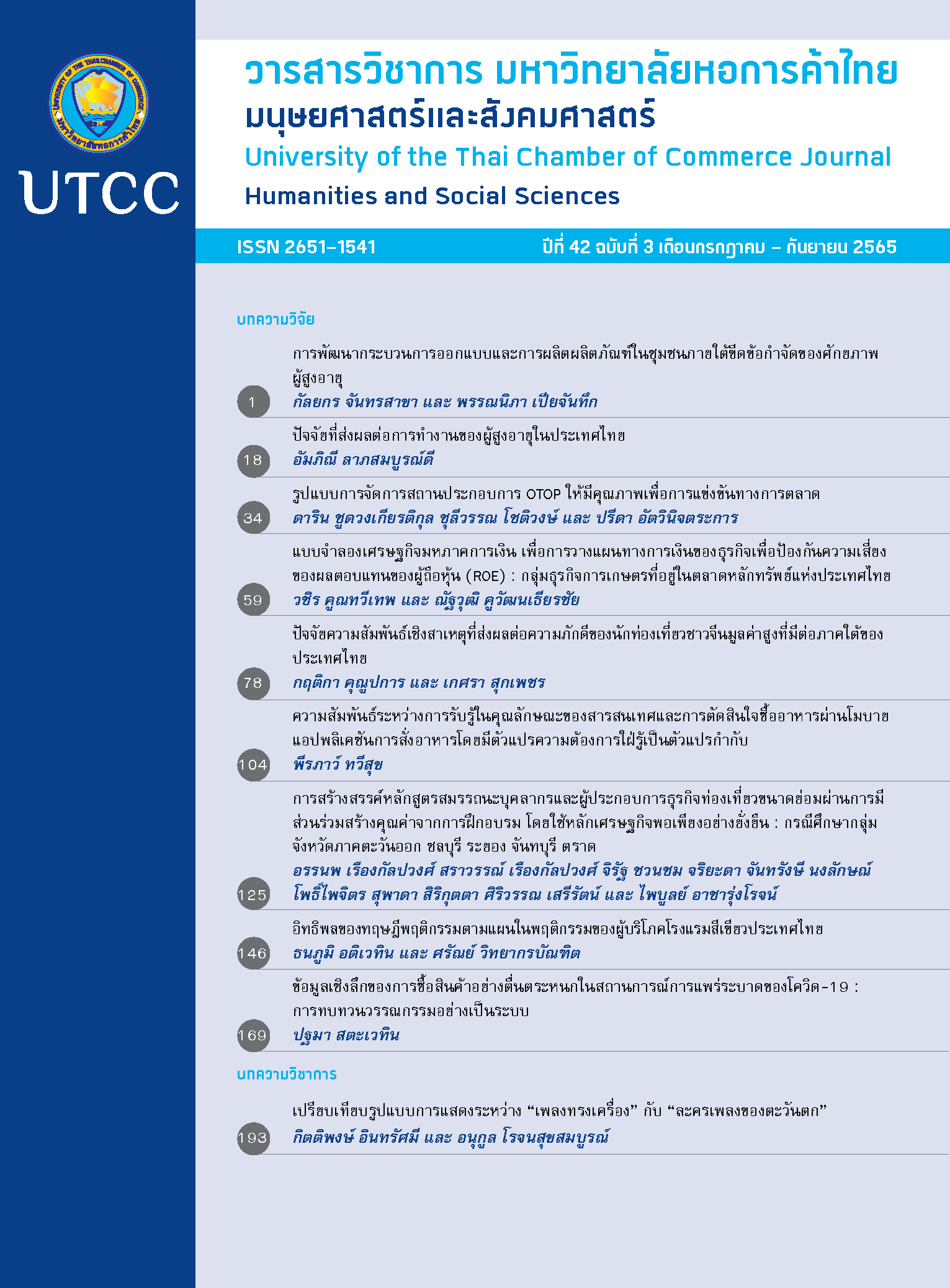A Macro-Financial Model for Business Financial Planning to Prevent the Risk Impacting the Return on Equity (ROE): Agribusinesses Listed on the Stock Exchange of Thailand
Main Article Content
Abstract
This study aimed to develop a macro financial model for business financial planning (MFM-FP), and to measure the efficiency of the forecasting model. In addition, the likelihood of the risk impacting the return on equity (ROE) and financial planning guidelines was examined by using economic data, income statements, and balance sheets of agribusinesses listed on the Stock Exchange of Thailand between 2016 and 2019. MFM-FP was built in the form of simultaneous equations by employing the 2SLS method. The mean absolute percentage error (MAPE) was used to assess the efficiency of the model, while the risk was considered by setting risk limits. DuPont analysis was brought in to build a financial plan in order to reduce the risk that could impact the ROE. The developed MFM-FP model contained 39 equations, divided into 15 identity equations, 22 behavioral equations, and 1 conditional equation; with 7 divided blocks. Ex-ante and Ex-post forecast accuracy of all financial statement factors (assessed by MAPE) were found to be no more than 3.08%. Results also showed that the forecasted ROE in Q1 of 2019 was -1.09%, which was within one standard deviation of the mean. However, if the GDP growth was -3.72%, the forecasted ROE would turn out to be -2.35%, indicating a high-risk level. Therefore, agribusinesses should mitigate the risk impacting the ROE by reducing costs, account receivables, and inventories.
Article Details

This work is licensed under a Creative Commons Attribution-NonCommercial-NoDerivatives 4.0 International License.
ลิขสิทธิ์ของบทความ
ผลงานที่ได้รับการตีพิมพ์ถือเป็นลิขสิทธิ์ของมหาวิทยาลัยหอการค้าไทย ห้ามมิให้นำเนื้อหา ทัศนะ หรือข้อคิดเห็นใด ๆ ของผลงานไปทำซ้ำ ดัดแปลง หรือเผยแพร่ ไม่ว่าทั้งหมดหรือบางส่วนโดยไม่ได้รับอนุญาตเป็นลายลักษณ์อักษรจากมหาวิทยาลัยหอการค้าไทยก่อน
References
Almazari, A. A. (2012). Financial performance analysis of the Jordanian Arab bank by using the DuPont system of financial analysis. International Journal of Economics and Finance, 4(4): 86-94. doi:10.5539/ijef.v4n4p86
Armstrong, J. S. (2009). Selecting forecasting methods. Retrieved from https://ssrn.com/abstract=1941247
Artikis, P. G., & Artikis, G. P. (1999). A stochastic simulation approach to financial forecasting using simultaneous equations. Managerial Finance, 25(8),12-21. https://doi.org/10.1108/03074359910766082
Bratu (Simionescu), Mihaela. (2012). Point forecasts based on the limits of the forecast intervals to improve the SPF predictions. Business and Economic Horizons, 8(2), 1-11.
Brown, L. D., & Huang, K. (2013). Recommendation-forecast consistency and earnings forecast quality. Accounting Horizons, 27(3), 451-467. https://doi.org/10.2308/acch-50482
Chang, K. J., Chichernea, D. C., & HassabElnaby, H. R. (2014). On the DuPont analysis in the health care industry. Journal of Accounting and Public Policy, 33(1), 83-103. https://doi.org/10.1016/j.jaccpubpol.2013.10.002
Francis, J. C., & Rowell, D. (1978). A simultaneous equation model of the firm for financial analysis and planning. Financial Management, 7(1), 29-44.
Gray, D. F., Merton, R. C., & Bodie, Z. (2007). New framework for measuring and managing macrofinancial risk and financial stability. Retrieved from https://www.nber.org/system/files/working_papers/w13607/w13607.pdf
Setsmart. (2018). Financial statement data. Retrieved January 12, 2022, from http://10.21.7.31:8080/ssm/stockScreening;market=all;securityType=S;industrySector


